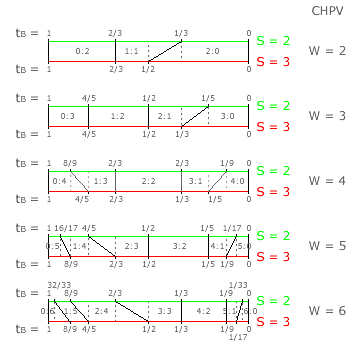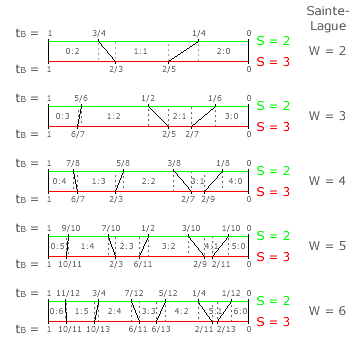Comparisons: Sainte-Laguë ~ Party Cloning 2
Comparative Susceptibility of CHPV and the Sainte-Laguë Method to Party Cloning
The party cloning threshold figures for CHPV are presented in the earlier Evaluations: Party Cloning section. To enable a direct comparison between the susceptibility of CHPV and the Sainte-Laguë method to party cloning, the relevant threshold figures for up to six winners are repeated below left for Sainte-Laguë and below right for CHPV.


Where elections are held here with two or three winners, CHPV is not susceptible to party cloning. For four, five or six winners, CHPV is only vulnerable when party B already has the majority share of the vote. With a minority share, party B gains nothing at best but risks harming itself quite significantly.
Where the party with minority support seeks to clone itself to increase its seat share, few-winner CHPV elections are not susceptible to such attempts but the Sainte-Laguë method is readily vulnerable. On the other hand, the Sainte-Laguë method always has a higher optimality than CHPV irrespective of the number of competing parties or vacant seats. Yet again, the trade-off between optimality and cloning susceptibility is obvious.
It is informative to compare CHPV with the two other highest averages methods. In terms of optimality within few-winner constituencies, CHPV is poorer than the Sainte-Laguë method but better than the D'Hondt method. In terms of cloning susceptibility within few-winner constituencies, CHPV is better than the Sainte-Laguë method but poorer than the D'Hondt method. Hence, for concurrent elections across multiple few-winner constituencies, party-list CHPV is the intermediate solution to the trade-off between these two crucial but opposing aspects. With no more than five winners, CHPV is more likely than the D'Hondt method to generate an optimally proportional election outcome here while simultaneously being invulnerable to cloning by the minority party; unlike the Sainte-Laguë method.
Proceed to next section > Comparisons: Sainte-Laguë ~ Proportionality
Return to previous page > Comparisons: Sainte-Laguë ~ Party Cloning 1
